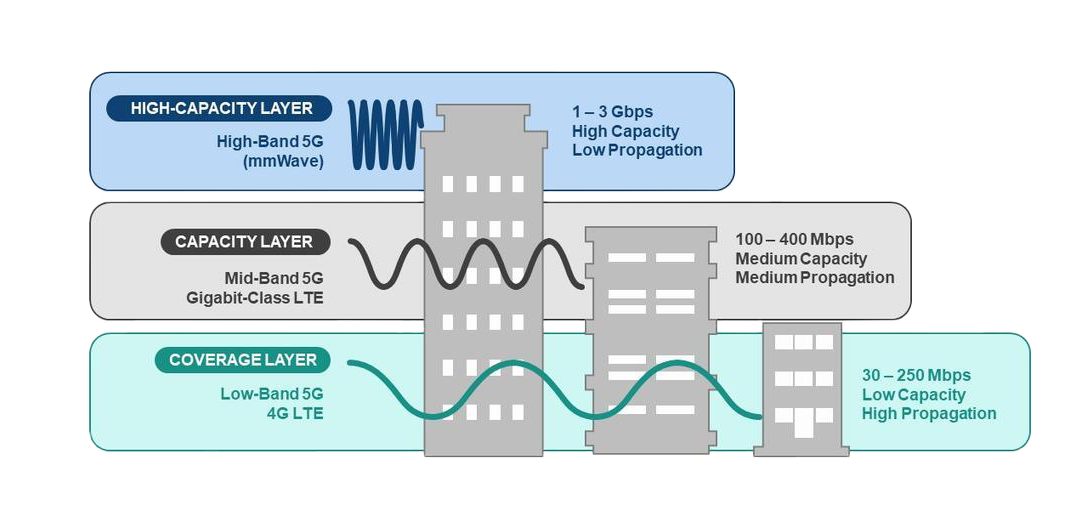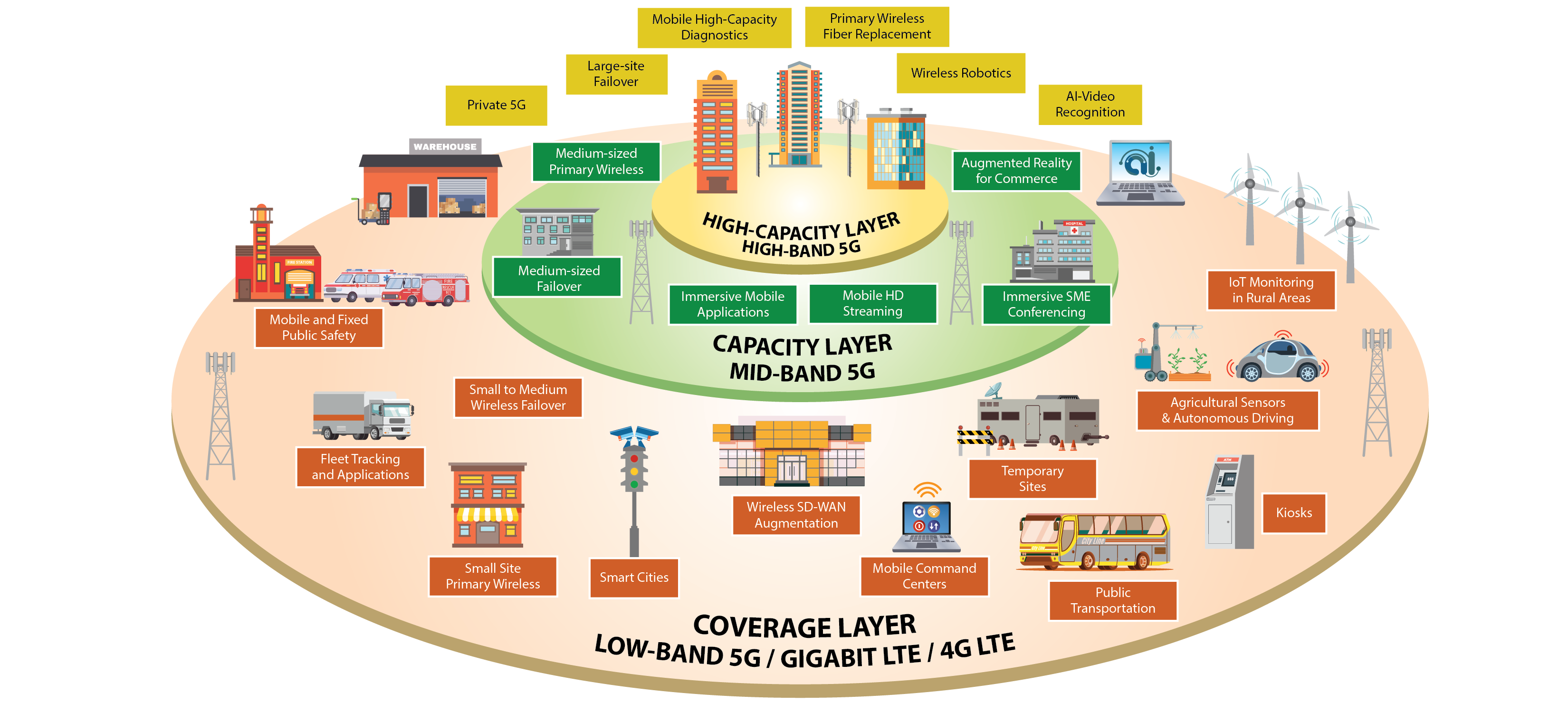5G Solutions for Enterprise & Government
Managed 5G networking for Internet of Things devices and self-guided robotic automation systems.
5G networks are a primary internet connectivity option for enterprises, small businesses, or government locations. 5G provides greater data throughput and less latency than previous 4G/LTE services. Service delivery locations that do not have existing, readily available fiber or cable connections can reliably and securely connect to the internet and utilize cloud applications and services. The high-bandwidth, low-latency attributes of 5G mean that these locations can use artificial intelligence (AI) supported video solutions
The Hughes Managed Enterprise 5G network offering incorporates multiple carriers into a single solution. Private 5G networking is an emerging solution.
Early use cases include manufacturing plants and distribution centers. As these locations implement autonomous mobile robots (AMRs), automated guided vehicles (AGVs), and other mobile robotic solutions, the highly accurate location sensing and ubiquitous coverage of a 5G network are critical. Private 5G utilizes a 5G signal, but only within the boundaries of a specific location. Hughes provides the signal and access technology for authorized devices to connect. Implementing a Private 5G network solution will provide 5G capabilities in a secure network specific to the facility.
Using public or private 5G networking delivers lower-cost, ubiquitous coverage for IoT devices, robotic automation tools, and solutions where high-bandwidth, always connected networking is required.
5G solutions increase access to smart technologies, cloud applications and artificial intelligence.
What does 5G stand for? 5G is the latest generation of cellular communication technology with better capacity, coverage, reliability, and lower latency. 4G/LTE made smartphones possible, and 5G will enable machine-to-machine (M2M) communications using IoT devices and artificial intelligence computing. Businesses and government agencies will have greater flexibility to utilize Smart technologies and cloud applications to deliver better services from more places.
Unlike previous cellular generations, 5G offers three different layers (called radio bands), low-band, mid-band, and high-band. Each layer delivers additional capacity and coverage. All layers have improved reliability and lower latency than previous generations.

Capabilities and use cases for each 5G layer.
Low-band 5G is the coverage layer. Like 4G/LTE, it is very good at penetrating buildings and has several miles' propagation radius (distance from the cell tower). Current 4G/LTE clocks about 30Mbps. With 5G low-band, speeds of 50Mbps to 70Mbps are possible. With the higher bandwidth, the low band is a good choice for small site primary internet connections, mobile or temporary location connectivity, and backup or failover links. The higher speeds and large propagation radius make the 5G low band useful for IoT device communication, for example, remote sensors and monitoring stations.
Mid-band 5G is the capacity layer. The increased bandwidth of 100Mbps to 200Mbps within a smaller propagation radius. With 5G mid-band, agencies and businesses can use streaming video, immersive video conferencing, and failover services for medium-sized locations.
High-band 5G is the ultra-capacity layer, with bandwidth speeds of 500Mbps to 1Gbps but a tight propagation radius of about 1500 feet. Obstructions such as buildings limit the bandwidth. 5G high band is exciting, but deployments are limited. As enterprise access to the 5G high band increases, AI vision recognition and real-time control of autonomous robots, drones, and vehicles, will increase.

While 5G doesn’t solve all current problems facing enterprises today, the greater throughput offered by all the bands can benefit many enterprise users. And this is just the beginning, new enterprise 5G capabilities like network slicing, private wireless networks, and location-sensing are coming. There are steps you can take now to position your organization to take advantage of all 5G has to offer.
Hughes is carrier agnostic and focused on connectivity.
Count on Hughes for the best service at each location. Hughes is a certified Cradlepoint Elite Partner for Enterprise 5G and offers plans from Verizon, T-Mobile, and AT&T. Hughes will tailor a wireless network to your needs and the available carrier service in each area. Let us help you connect and build an enterprise network using 5G and LTE.
Thinking about Enterprise 5G? Here are some things to consider.
As discussed above, 5G service has three layers and each layer has increasing bandwidth and decreasing reach and availability. 5G service is the future and government agencies, enterprises and small businesses should have a plan to integrate 5G into their network. The deployment timing depends on existing hardware refresh timelines, desired system capabilities, and anticipated use cases.
Non-standalone (NSA) mode and standalone (SA) mode, what does it mean?
The carriers wanted to deliver 5G service quickly and support 5G devices, so they implemented non-standalone (NSA) mode. NSA mode means they support 5G devices connecting to their towers and route the 5G signal into the existing 4G core network. This configuration allows 5G devices to be purchased and used while the carriers work on updating their core infrastructure. While operating in NSA mode, the 5G devices will connect, but the speeds will be limited to what 4G/LTE has been providing.
The next step will be an upgrade to Stand Alone (SA) mode. As the carriers update their networks, there will increasingly be access to 5G core network infrastructure, enabling the ultra-low latency, network slicing, and gigabit speeds possible with 5G.
Contact us to speak with a Hughes enterprise 5G solutions expert to learn more about the technology and how it can be deployed to benefit your organization.
Related Resources



Experts from Hughes and Cradlepoint discuss the merits and applications of 5G.




